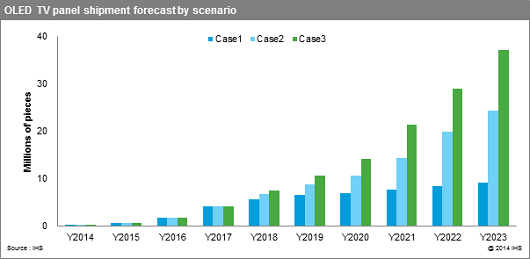OLED/Market Forecast – IHS has published a report on the potential of the OLED TV market, examining the current situation and likely development paths. The market forecast covers the period from 2014 to 2023.
The analyst sees the current position of the OLED TV market in a pre-market phase as only LG has the capacity and commitment to produce large size OLED panels for the TV market. While other display manufacturers have invested in OLED fabs, their production yields and costs are not competitive in the TV market. So far, OLED still sells at a steep premium over LCD.
IHS sees that the adoption of new manufacturing technology will be needed to break this cost barrier and make OLED TVs successful in the market. OLED panels provide better image quality in terms of color rendition and black levels compared to conventional LCD panels. However, the LCD makers have responded quickly to the challenge by increasing image quality and viewing angle. This, combined with high production yields and a competitive LCD supply chain, makes it hard for OLED to break into the TV market.
The report says that the OLED industry has to embrace new technologies, such as direct printing instead of thermal evaporation, to improve material efficiency. IHS also sees this as a chance to create OLED panels based on flexible substrates, which will in turn allow the creation of new products to drive the TV market in the future.
As a consequence IHS sees three distinct scenarios developing for OLED TV. Case 1 and the lowest scenario is based on glass substrates and a thermal evaporation process. Case 2 is based on glass substrates and a direct printing process, while case 3 is based on flexible substrates and a printing process. This creates the following forecast.

While case 1 shows a stagnant panel volume, case 2 and case 3 show a growing market as OLED TVs start replacing LCD TVs in the future. The research from IHS shows that the future of OLED for the TV market hinges on the right manufacturing technology and the resulting production cost, as well as creating an additional market advantage through the use of flexible OLED panels. – Norbert Hildebrand

